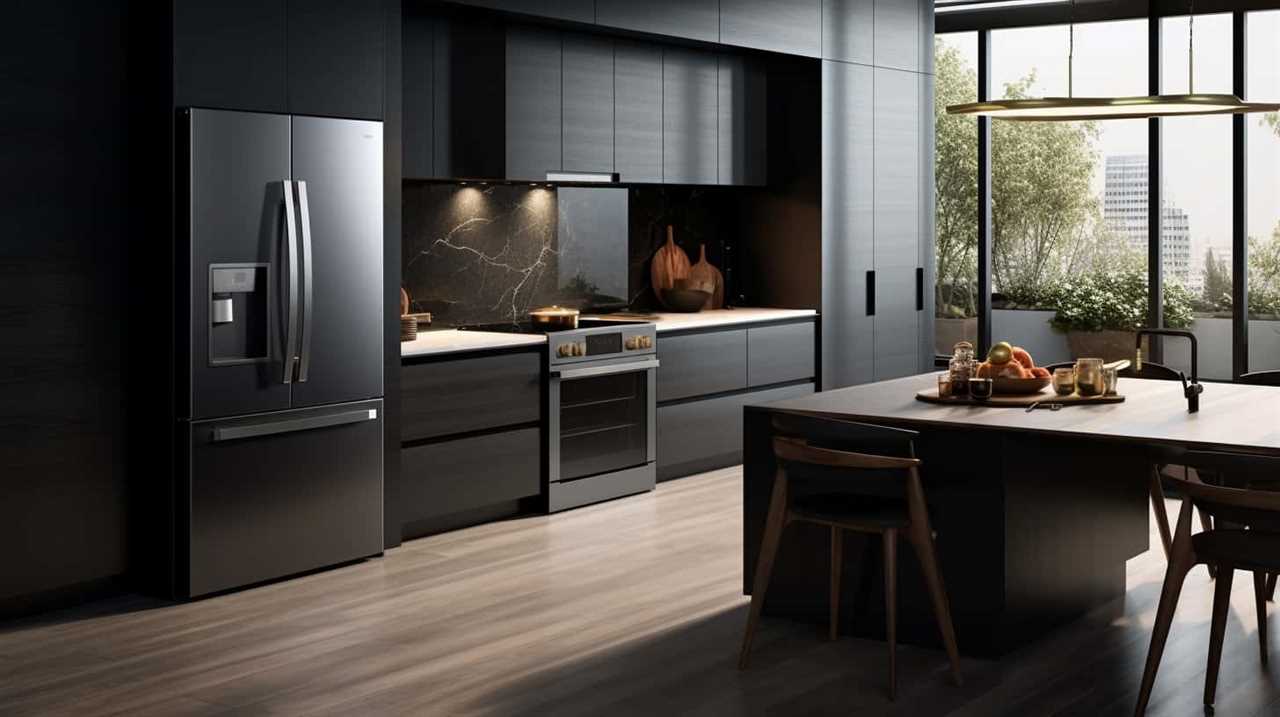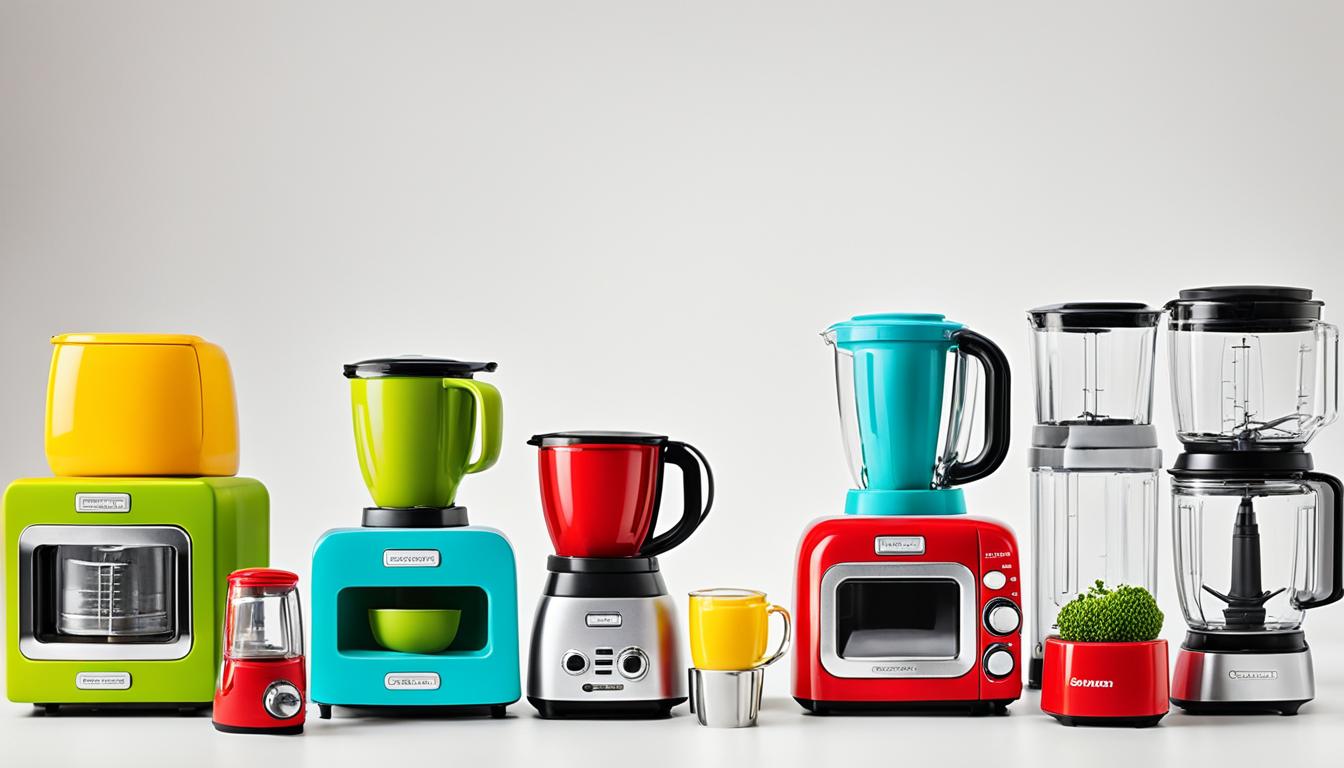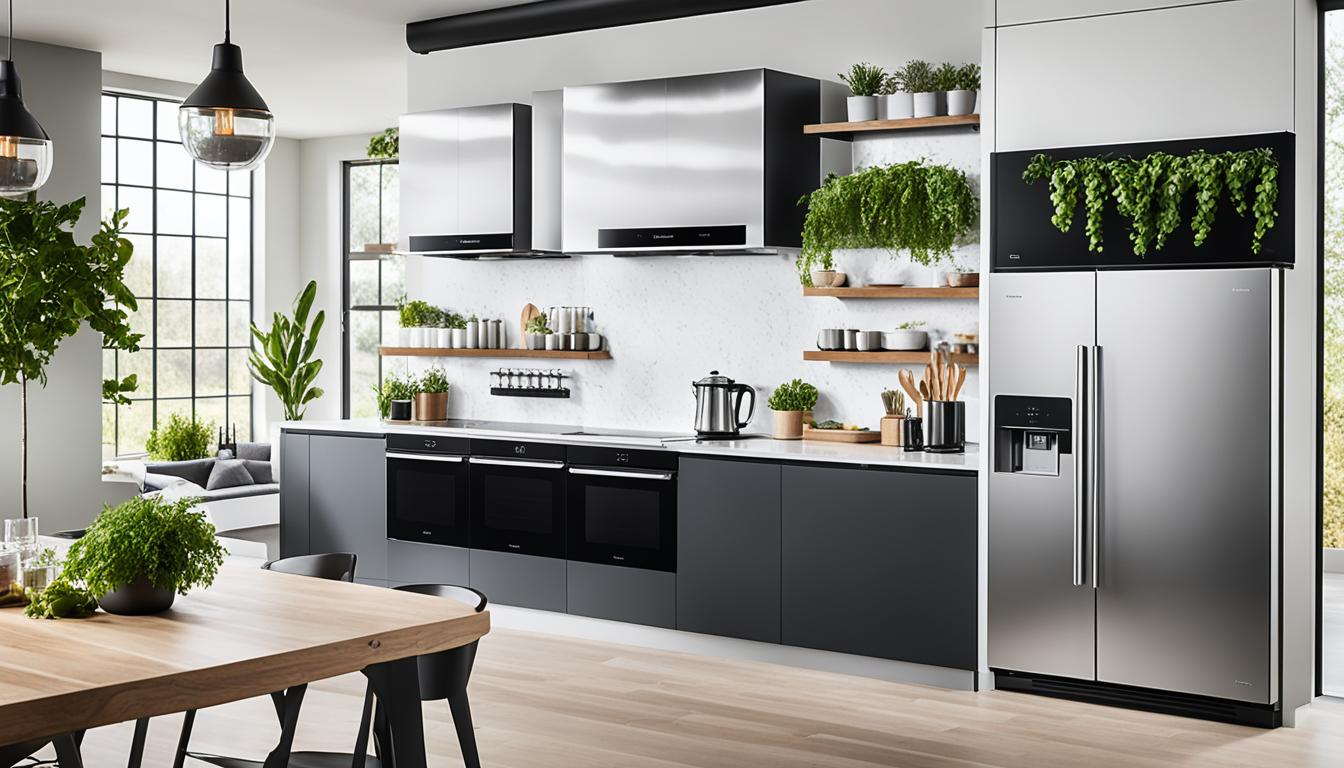If you want to improve your home’s energy efficiency, you should take a look at the 13 key advantages of energy-efficient appliances. These appliances offer numerous benefits that can enhance your quality of life.
By making the switch to energy efficient appliances, you can experience lower energy bills, reduce your environmental impact, and increase your energy savings. Not only that, but these appliances also boast a longer lifespan, improved indoor air quality, and minimized greenhouse gas emissions.
Additionally, you can enjoy lower maintenance and repair costs, enhanced appliance performance, and even a positive impact on your home’s resale value.
With these 13 key benefits, energy efficient appliances are a wise choice for those seeking mastery over their energy usage.

Key Takeaways
- Energy efficient appliances lead to lower energy bills over time.
- They help lower carbon emissions and contribute to climate change mitigation.
- Energy efficient appliances conserve resources such as energy, water, and natural gas.
- They promote sustainable energy consumption and contribute to a healthier planet.
Lower Energy Bills
One of the major advantages of energy efficient appliances is that they can lead to lower energy bills over time. By implementing energy saving tips and investing in energy efficient home improvements, homeowners can significantly reduce their monthly utility costs. Energy efficient appliances are designed to consume less electricity or gas compared to their traditional counterparts without compromising on performance. This means that not only are consumers saving money, but they’re also minimizing their impact on the environment.
There are several ways in which energy efficient appliances contribute to lower energy bills. Firstly, these appliances are designed to use energy more efficiently, which reduces the amount of electricity or gas needed to operate them. For example, energy efficient refrigerators use advanced technologies such as improved insulation and compressors to maintain optimal temperatures while consuming less power. Secondly, energy efficient appliances often come with built-in features that allow users to customize energy usage according to their needs. This enables homeowners to further reduce energy consumption and subsequently, their bills.
Investing in energy efficient home improvements, such as upgrading to energy efficient windows or insulating the attic, can also contribute to lower energy bills. These improvements help to seal any air leaks and prevent heat transfer, resulting in reduced energy usage for heating and cooling. Additionally, installing programmable thermostats allows homeowners to set specific temperatures for different times of the day, optimizing energy usage and reducing costs.
Lower energy bills not only benefit homeowners financially, but they also have a positive impact on the environment. By consuming less energy, energy efficient appliances help to reduce greenhouse gas emissions and combat climate change. This transition to energy efficient appliances and home improvements is a step towards a more sustainable future.

In the next section, we’ll explore another significant benefit of energy efficient appliances: their reduced environmental impact.
Reduced Environmental Impact
When it comes to energy efficient appliances, one of the key benefits is the reduced environmental impact they have.
By using these appliances, we can lower carbon emissions, which contribute to climate change. Additionally, they help conserve resources by using less energy, water, and natural gas.
Ultimately, energy efficient appliances promote sustainable energy consumption and play a vital role in protecting our environment for future generations.

Lower Carbon Emissions
Energy efficient appliances contribute to a significant reduction in carbon emissions, resulting in a positive impact on the environment. By using less energy to perform the same tasks, these appliances help to lower our carbon footprint.
Carbon emissions are a major contributor to climate change, and reducing them is crucial for climate change mitigation efforts. Energy efficient appliances achieve this by using advanced technologies that minimize energy wastage and maximize efficiency. They consume less electricity, which means less reliance on fossil fuels for electricity generation.
This leads to a decrease in greenhouse gas emissions, helping to combat global warming. By choosing energy efficient appliances, we can actively contribute to reducing our environmental impact and creating a more sustainable future.
Conservation of Resources
By choosing energy efficient appliances, we can actively contribute to conserving resources and reducing our environmental impact. Resource management and sustainable practices are key aspects of this effort.

Energy efficient appliances are designed to use less energy, which directly translates into reduced consumption of natural resources such as coal, oil, and gas. Additionally, these appliances often have features that optimize water usage, further conserving this precious resource. By minimizing our resource consumption, we can help preserve these finite resources for future generations.
Furthermore, energy efficient appliances also have a positive impact on our environment by reducing greenhouse gas emissions and pollution. This not only improves air quality, but also helps mitigate the effects of climate change.
Therefore, investing in energy efficient appliances is a smart choice for those who desire to make a meaningful contribution to resource conservation and sustainable living.
Sustainable Energy Consumption
We frequently choose energy efficient appliances to actively reduce our environmental impact and ensure sustainable energy consumption. Energy conservation is a crucial aspect of sustainable living, as it helps us minimize our carbon footprint and preserve our planet’s resources. By using energy efficient appliances, we decrease the amount of electricity consumed, reducing the demand for non-renewable energy sources such as fossil fuels. This, in turn, helps to decrease greenhouse gas emissions and combat climate change.

Additionally, sustainable energy consumption promotes the use of renewable energy sources like solar or wind power, which have minimal environmental impact. By embracing energy efficiency, we can contribute to a more sustainable future and create a healthier planet for generations to come.
Transitioning into the next section about increased energy savings, let’s explore how energy efficient appliances can also help us save money on our utility bills.
Increased Energy Savings
When it comes to energy efficient appliances, one of the key benefits is the increased energy savings. By using appliances that are designed to consume less energy, we can significantly reduce our utility bills.
Not only does this save us money, but it also contributes to environmental sustainability by reducing our overall energy consumption.

Lower Utility Bills
One of the major benefits of energy efficient appliances is that they can significantly reduce our utility bills. By using appliances that consume less energy, we can save a substantial amount of money on our monthly bills.
Here are three ways in which energy efficient appliances can help lower our utility bills:
- Energy Consumption Analysis: Energy efficient appliances are designed to use less energy, which means they consume less electricity or gas. This leads to reduced utility bills.
- Energy Efficient Home Design: Appliances that meet energy efficiency standards are often part of a larger home design strategy. This includes insulation, windows, and lighting systems that work together to minimize energy waste, resulting in lower utility bills.
- Smart Technology Integration: Many energy efficient appliances come with smart technology features that allow us to control and monitor our energy usage. By optimizing our energy consumption, we can further reduce our utility bills.
Environmental Sustainability
To achieve environmental sustainability through increased energy savings, it’s crucial to prioritize the use of energy efficient appliances. By doing so, we can significantly contribute to climate change mitigation and promote renewable energy integration.
Energy efficient appliances consume less electricity, reducing the demand for fossil fuels and lowering greenhouse gas emissions. This helps to combat climate change by minimizing the release of harmful pollutants into the atmosphere.

Additionally, energy efficient appliances can support the integration of renewable energy sources by reducing the strain on the power grid. With lower energy consumption, renewable energy systems can meet a larger percentage of our energy needs.
By embracing energy efficient appliances, we can make a substantial impact on the environment and pave the way for a sustainable future.
Transitioning to the next section, let’s explore the benefits of longer appliance lifespan.
Longer Appliance Lifespan
We have found that energy efficient appliances tend to have a longer lifespan compared to their less efficient counterparts. This is due to a combination of factors that contribute to increased durability and cost-effective maintenance. Here are three reasons why energy efficient appliances last longer:

- Improved build quality: Energy efficient appliances are designed with higher quality materials and components. This results in appliances that are more robust and resistant to wear and tear. The improved build quality ensures that these appliances can withstand daily use and continue functioning at optimal levels for a longer period of time.
- Reduced strain on components: Energy efficient appliances are engineered to operate more efficiently, which means they require less energy to perform their tasks. This reduced energy consumption results in less strain on the internal components of the appliance. By reducing stress on the various parts, energy efficient appliances experience less wear and tear, leading to a longer lifespan.
- Regular maintenance: Energy efficient appliances often come with features that facilitate regular maintenance. These features make it easier to clean and maintain the appliances, ensuring they continue to operate efficiently. By adopting a proactive approach to maintenance, energy efficient appliances can be kept in optimal condition, extending their lifespan and reducing the need for costly repairs.
Investing in energy efficient appliances not only helps reduce energy consumption and save money on utility bills, but also provides the added benefit of a longer lifespan. By choosing appliances that prioritize energy efficiency, you can enjoy the benefits of increased durability and cost-effective maintenance, ultimately saving you time, money, and the hassle of frequent replacements.
Improved Indoor Air Quality
When it comes to energy efficient appliances, one of the key benefits is the improved indoor air quality they provide. By using these appliances, we can create a healthier breathing environment for ourselves and our families.
This can result in reduced respiratory illnesses, cleaner air, and happier lungs.
Healthier Breathing Environment
Improving indoor air quality is essential for creating a healthier breathing environment, achieved through the use of energy efficient appliances. When we prioritize a healthier breathing environment, we reap numerous health benefits and experience improved well-being. Consider the following:
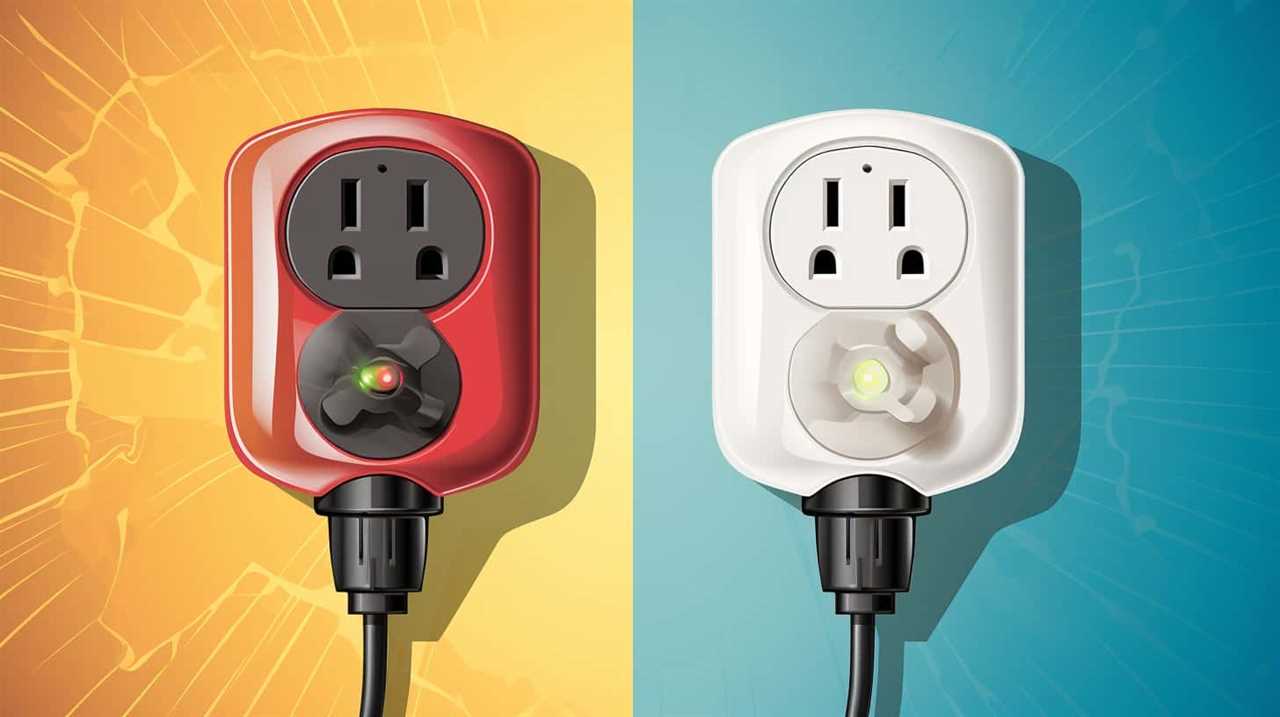
- Reduced allergens: Energy efficient appliances filter out more dust, pollen, and other allergens from the air, ensuring cleaner and healthier indoor air quality. This can alleviate symptoms for those with allergies and respiratory conditions.
- Decreased exposure to harmful pollutants: Energy efficient appliances emit fewer pollutants such as volatile organic compounds (VOCs) and carbon monoxide, which can have detrimental effects on our health. By using these appliances, we create a safer and healthier environment for ourselves and our families.
- Enhanced ventilation: Energy efficient appliances are designed to provide better airflow and ventilation, facilitating the circulation of fresh air throughout our living spaces. This helps to reduce the buildup of indoor air pollutants and promotes a healthier breathing environment.
Reduced Respiratory Illnesses
By prioritizing a healthier breathing environment with energy efficient appliances, we can significantly reduce the occurrence of respiratory illnesses.
Respiratory health is closely linked to the quality of the air we breathe. Traditional appliances, such as old refrigerators or air conditioners, can release harmful pollutants into the air, contributing to indoor air pollution. These pollutants can irritate the respiratory system, leading to a higher risk of developing respiratory illnesses such as asthma, bronchitis, or allergies.
Energy efficient appliances, on the other hand, are designed to minimize the release of pollutants, improving indoor air quality and reducing the risk of respiratory issues. They use advanced filtration systems and technology to remove impurities and maintain a healthier breathing environment.
Cleaner Air, Happier Lungs
Our lungs will thank us for investing in energy efficient appliances that improve indoor air quality. When we’ve a cleaner environment, we experience numerous health benefits. Consider the following:

- Purified air: Energy efficient appliances filter out pollutants, such as dust, pet dander, and mold spores. This means we breathe in cleaner air, reducing the risk of respiratory issues and allergies.
- Reduced chemical exposure: Energy efficient appliances use eco-friendly materials and reduce the emission of harmful chemicals. This helps us avoid breathing in toxins and volatile organic compounds (VOCs), promoting overall lung health.
- Humidity control: Energy efficient appliances, like dehumidifiers, help maintain optimal humidity levels in our homes. By preventing excess moisture, we discourage the growth of mold and mildew, which can trigger respiratory problems.
Investing in energy efficient appliances not only saves us money and conserves energy, but also ensures a cleaner indoor environment, leading to happier lungs and better overall health.
Enhanced Home Comfort
With energy efficient appliances, we can create a more comfortable home environment. These appliances offer improved temperature control, ensuring that our homes stay at the desired temperature without any fluctuations. By using energy efficient heating and cooling systems, we can maintain a consistent and comfortable indoor climate throughout the year.
This enhanced temperature control also benefits our sleep quality. A comfortable sleeping environment is essential for a good night’s rest, and energy efficient appliances contribute to creating such an environment. For example, energy efficient air conditioners can maintain a cool and comfortable temperature in our bedrooms, promoting better sleep. Additionally, energy efficient appliances produce less noise, ensuring a peaceful and undisturbed sleep.
Investing in energy efficient appliances not only enhances our home comfort but also reduces our energy bills. These appliances are designed to use less energy while still providing the same level of performance. This means that we can enjoy a comfortable home without worrying about high energy costs.

Furthermore, energy efficient appliances are environmentally friendly, reducing our carbon footprint and contributing to a sustainable future.
Government Incentives and Rebates
Taking advantage of government incentives and rebates can greatly reduce the cost of purchasing energy efficient appliances. These programs are designed to encourage consumers to choose appliances that are more energy efficient, thereby reducing overall energy consumption. Here are three key benefits of utilizing incentives and rebates:
- Financial savings: By participating in these programs, consumers can save a significant amount of money on the purchase of energy efficient appliances. Incentives and rebates can cover a portion of the cost or provide a direct discount, making these appliances more affordable for everyone.
- Increased affordability: With the help of incentives and rebates, the initial investment in energy efficient appliances becomes more manageable. This allows consumers to upgrade their appliances without straining their budgets, making it easier for households to transition to more sustainable and efficient technologies.
- Environmental impact: By choosing energy efficient appliances, consumers not only save money but also contribute to reducing greenhouse gas emissions. Energy efficient appliances consume less energy, leading to a decrease in carbon emissions and a positive impact on the environment.
Greater Energy Independence
We frequently experience greater energy independence when we use energy efficient appliances. By reducing our energy consumption, we become less reliant on external sources for our energy needs. This increased energy independence has several key benefits, including enhanced energy security and greater integration of renewable energy sources.
Energy security is a crucial aspect of achieving energy independence. Energy efficient appliances help us to reduce our overall energy demand, making us less vulnerable to fluctuations in energy prices and supply. By using less energy, we can also decrease our dependence on imported energy sources, which can be subject to geopolitical tensions and market volatility. This enhanced energy security provides stability and resilience to our energy systems.
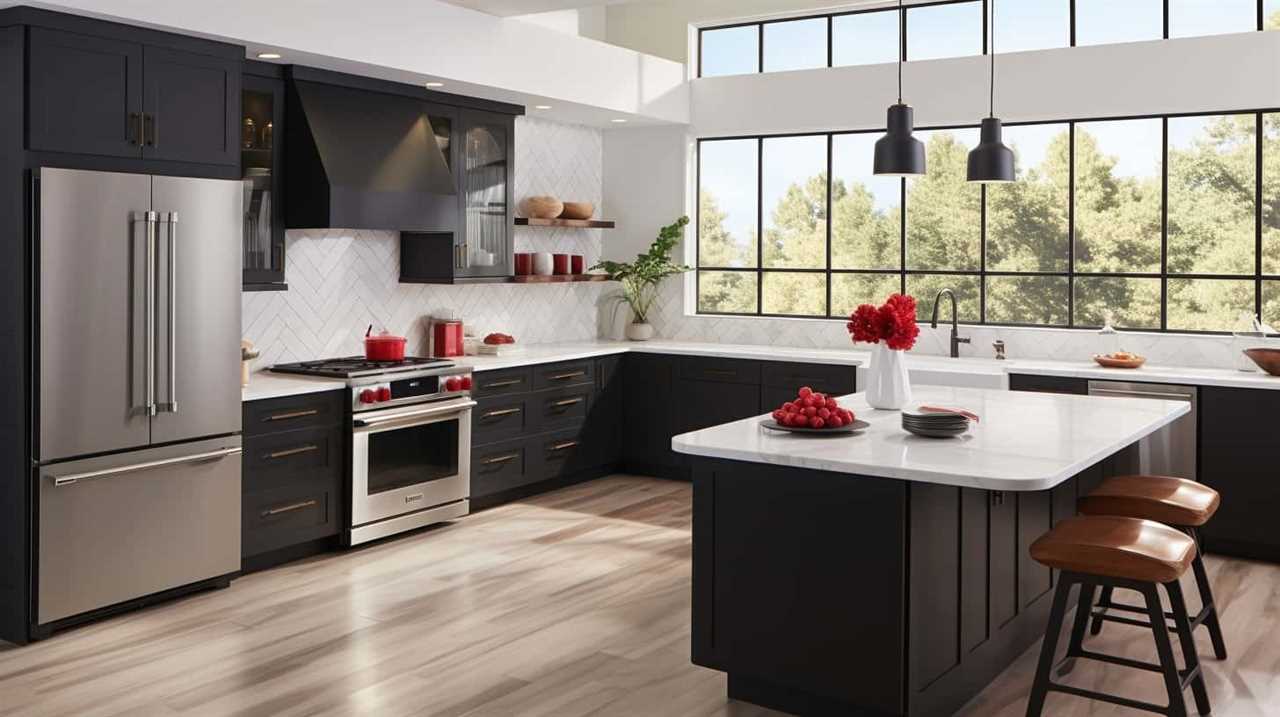
Furthermore, energy efficient appliances contribute to the integration of renewable energy sources. As we reduce our energy consumption, we create space for renewable energy to play a larger role in meeting our energy needs. By using energy efficient appliances, we can optimize the utilization of renewable energy sources, such as solar and wind power. This integration of renewable energy not only reduces our reliance on fossil fuels but also helps to mitigate climate change and promote sustainability.
Reduced Reliance on Fossil Fuels
Energy efficient appliances significantly decrease our reliance on fossil fuels. This reduction in fuel consumption has a direct impact on our carbon footprint, helping to mitigate climate change. Here are three ways in which energy efficient appliances contribute to this reduction:
- Lower Energy Consumption: Energy efficient appliances are designed to use less energy while still providing the same level of functionality. This means that they require less electricity or gas to operate, resulting in reduced fuel consumption and lower greenhouse gas emissions. This not only helps to preserve our planet’s resources but also reduces our contribution to global warming.
- Advanced Technologies: Energy efficient appliances incorporate advanced technologies that optimize energy usage. For example, refrigerators with improved insulation and compressor systems can maintain temperature more efficiently, reducing the need for frequent cooling cycles and saving energy. Similarly, washing machines with sensor technology can adjust water levels and cycle times based on the load size, further minimizing energy and water consumption.
- Renewable Energy Integration: Energy efficient appliances can be easily integrated with renewable energy sources such as solar panels or wind turbines. By using clean, renewable energy to power these appliances, we can further decrease our reliance on fossil fuels and reduce our carbon footprint.
Minimized Greenhouse Gas Emissions
By regularly maintaining and upgrading our appliances, we can significantly reduce greenhouse gas emissions. Energy efficient appliances play a crucial role in minimizing energy consumption and promoting sustainable living. When appliances are designed to operate with minimal energy usage, they require less electricity or fuel to function properly. This directly translates to lower greenhouse gas emissions, as the production of electricity often relies on the burning of fossil fuels, which releases carbon dioxide and other greenhouse gases into the atmosphere.
In addition to reducing energy consumption, energy efficient appliances also contribute to sustainable living by helping to combat climate change. Greenhouse gases, such as carbon dioxide, contribute to the warming of the Earth’s atmosphere, leading to adverse effects on the environment and human health. By minimizing greenhouse gas emissions, energy efficient appliances help mitigate climate change and its associated impacts.

Furthermore, adopting energy efficient appliances not only benefits the environment but also offers economic advantages. Lower energy consumption means reduced utility bills, enabling households to save money in the long run. Additionally, governments and organizations often provide incentives and rebates for the purchase and installation of energy efficient appliances, further encouraging their adoption.
Lower Maintenance and Repair Costs
Investing in energy efficient appliances can lead to significant savings on maintenance and repair expenses. When you choose energy efficient appliances, you not only save on your monthly utility bills, but you also reduce the need for frequent maintenance and costly repairs. Here are three reasons why energy efficient appliances can help you save on maintenance and repair costs:
Improved Durability: Energy efficient appliances are designed to be more durable and long-lasting. They’re built with high-quality materials and advanced technology, which means they’re less likely to break down or require repairs. This durability can save you money on maintenance and repair expenses over the lifespan of the appliance.
Enhanced Performance: Energy efficient appliances are designed to operate more efficiently, which means they experience less wear and tear. They run smoothly and effectively, reducing the risk of malfunctions and breakdowns. This improved performance can help you avoid costly repairs and minimize the need for maintenance.

Extended Warranty Coverage: Many energy efficient appliances come with extended warranty coverage. These warranties can provide additional protection and peace of mind, as they often cover the cost of repairs and maintenance during the warranty period. By choosing energy efficient appliances with extended warranty coverage, you can further reduce your maintenance and repair expenses.
Investing in energy efficient appliances not only benefits the environment and lowers your energy bills, but it also helps you save on maintenance and repair costs. By choosing appliances that are durable, perform efficiently, and come with extended warranty coverage, you can enjoy the long-term benefits of reduced maintenance and repair expenses.
Enhanced Appliance Performance
When we choose energy efficient appliances, we can experience enhanced performance, resulting in smoother operation and a reduced risk of malfunctions and breakdowns. These appliances are designed to optimize energy usage and improve efficiency, allowing them to perform at their best while conserving energy. With improved efficiency, energy is used more effectively, leading to better performance and overall functionality.
Energy efficient appliances are built with advanced technologies that enable them to operate more smoothly and quietly. They’re designed to minimize vibrations and noise, providing a more pleasant user experience. Moreover, these appliances are equipped with features that enhance performance, such as faster heating or cooling times, precise temperature control, and improved airflow.

By choosing energy efficient appliances, we not only benefit from their enhanced performance, but also contribute to energy conservation. These appliances consume less energy, reducing our carbon footprint and preserving our planet’s resources. Additionally, energy efficiency helps to lower utility bills, saving us money in the long run.
The improved performance of energy efficient appliances has a positive impact on their resale value. Potential buyers are attracted to appliances that offer superior performance and energy savings. This makes energy efficient appliances a valuable investment, as they not only provide immediate benefits but also hold their value over time.
In the next section, we’ll explore the positive impact that energy efficient appliances have on the resale value of our homes.
Positive Impact on Resale Value
Energy efficient appliances can significantly increase the resale value of our homes. When potential buyers see that our home is equipped with energy efficient appliances, they recognize the added value it brings.

Here are three reasons why energy efficient appliances have a positive impact on resale value and improved marketability:
- Cost savings: Energy efficient appliances help homeowners save on utility bills, making our homes more attractive to buyers. These appliances consume less energy, resulting in lower electricity, gas, and water bills. Potential buyers appreciate the long-term cost savings associated with energy efficient appliances, making our homes more appealing in the competitive real estate market.
- Environmental consciousness: As more people become environmentally conscious, the demand for energy efficient homes increases. By having energy efficient appliances, we demonstrate our commitment to sustainability. Potential buyers are more likely to choose our homes over others because they align with their values and contribute to a greener future.
- Enhanced home performance: Energy efficient appliances not only save money and reduce environmental impact, but they also improve the overall performance of our homes. These appliances are designed to be more durable, reliable, and efficient, resulting in fewer maintenance issues. This added benefit increases the perceived value of our homes and makes them more marketable.
Frequently Asked Questions
Are There Any Specific Energy-Efficient Appliances That Are Recommended for Reducing Greenhouse Gas Emissions?
There are definitely specific energy-efficient appliances that we recommend for reducing greenhouse gas emissions. These appliances have a significant impact on our home comfort as well.
By investing in energy-efficient appliances, we can greatly reduce our carbon footprint and contribute to a cleaner environment. Not only do these appliances save energy, but they also save us money on our utility bills in the long run.
How Do Energy-Efficient Appliances Contribute to Enhanced Home Comfort?
Energy-efficient appliances contribute to enhanced home comfort by providing a more pleasant living environment while saving energy and reducing costs. These appliances, such as energy-efficient air conditioners and heaters, maintain optimal temperature levels, ensuring a comfortable atmosphere throughout the year.
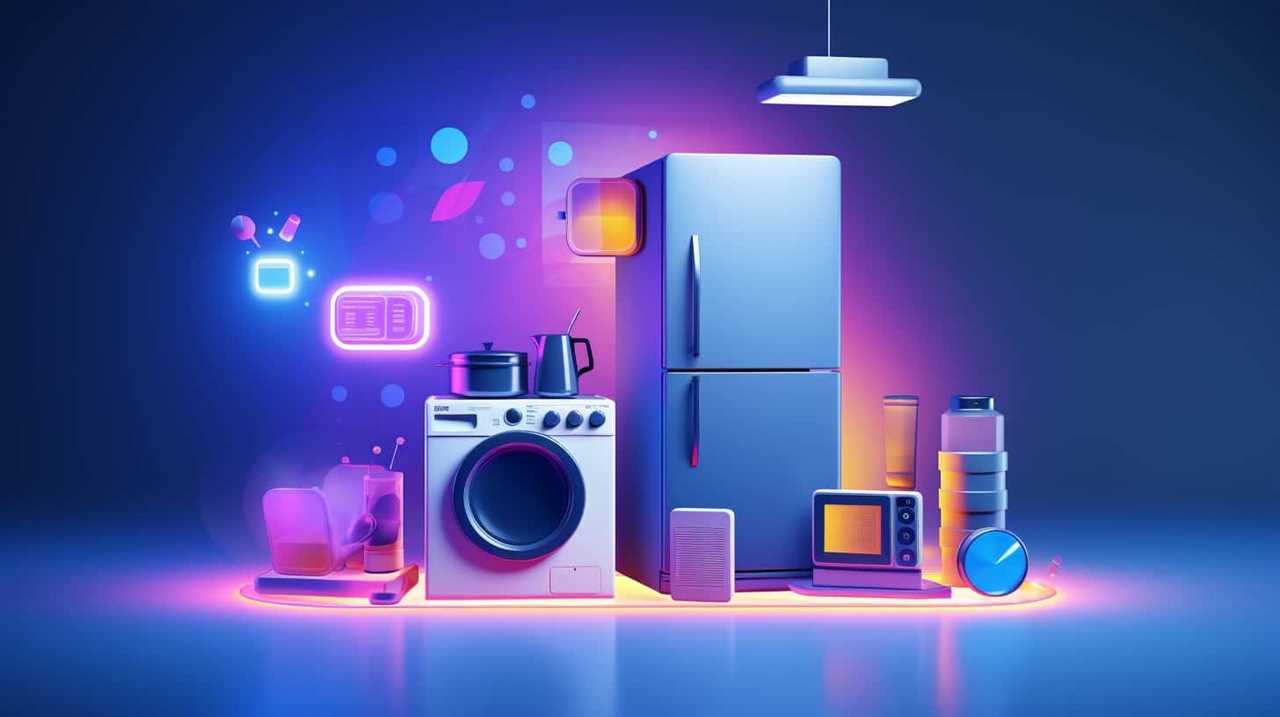
With their advanced features and technologies, they also help in reducing noise levels, improving indoor air quality, and minimizing temperature fluctuations. By using energy-efficient appliances, we can enjoy a cozy home while saving money on utility bills and reducing our environmental impact.
What Are Some Examples of Government Incentives and Rebates Available for Purchasing Energy-Efficient Appliances?
Government incentives and energy efficient appliance rebates are valuable resources for those looking to purchase eco-friendly appliances. These incentives and rebates act as financial incentives, encouraging consumers to invest in energy-saving technologies. By taking advantage of these programs, individuals can’t only save money on their appliance purchases but also contribute to a more sustainable future.
From tax credits to cash rebates, there are various options available that make it easier and more affordable to choose energy-efficient appliances for your home.
Can Using Energy-Efficient Appliances Help Reduce the Reliance on Fossil Fuels?
Using energy-efficient appliances can definitely help reduce our reliance on fossil fuels. These appliances are designed to use less energy, which means we can decrease the amount of electricity generated from fossil fuel sources.

By using energy-efficient appliances, we can conserve energy and reduce greenhouse gas emissions, ultimately helping to mitigate the impacts of climate change.
Additionally, using these appliances can also lead to cost savings on our energy bills, making it a win-win situation for both the environment and our wallets.
Do Energy-Efficient Appliances Have a Positive Impact on the Resale Value of a Home?
Energy-efficient appliances can have a significant positive impact on the resale value of a home. When potential buyers see energy-efficient appliances, they perceive the home as being more modern, environmentally friendly, and cost-effective to run. This can make the home more appealing and increase its value in the market.
Conclusion
In conclusion, energy efficient appliances offer numerous benefits that go beyond just lower energy bills.

Did you know that by replacing old appliances with energy efficient ones, you can reduce your household’s carbon footprint by up to 35%? That’s a significant impact on the environment!
Additionally, these appliances have a longer lifespan, improve indoor air quality, and even enhance resale value.
So why not make the switch to energy efficiency and start enjoying the many advantages it brings?
